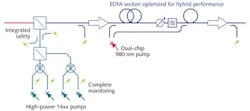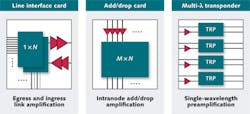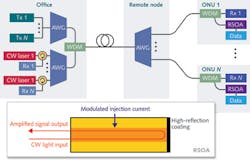PHOTONICS APPLIED: COMMUNICATIONS: Optical amplifiers increase communications network reach
For the past 15 years, optical amplifiers have played a key role in meeting the dramatic growth in bandwidth demand from consumers as well as enterprises by enabling optical fiber communication networks based on dense wavelength-division multiplexing (DWDM). They have also made possible greatly increased system reach and reconfigurable optical add/drop multiplexer (ROADM)-based wavelength routed optical networking.
With the constant quest to reduce network cost and increase functionality, optical amplifier designs continue to advance. Two dominant trends are currently driving the evolution of metro and long-haul optical networks: 1) reducing equipment and fiber cost by increasing capacity without reducing system reach; and 2) increasing the equipment utilization and ability to respond to more dynamically varying and rapidly growing traffic demands by the use of ROADM-based optical networking.
The EDFA workhorse
The introduction of erbium-doped fiber amplifiers (EDFAs) in the 1990s heralded the optical amplifier/DWDM revolution. These amplifiers increased system capacity by two orders of magnitude while simultaneously increasing system reach and reducing the need for costly optical-electronic-optical regenerators.
The EDFA is based on a singlemode fiber with an erbium-doped core, which—when pumped with suitable laser light (typically 980 nm or sometimes 1480 nm laser diodes)—amplifies optical signals with wavelengths across the C-band (roughly 1528–1565 nm). It has many advantages including modest pump-power requirements, high output power (now 23 dBm although with high-power pumps even higher powers are attainable), near quantum-limited noise performance, polarization insensitivity, and slow gain dynamics permitting operation in deep saturation without suffering gain-mediated crosstalk among DWDM channels.
When used in DWDM systems, EDFAs typically have multistage architectures incorporating gain-flattening filters, internal variable optical attenuators (VOAs), and automatic gain control to provide a flat gain spectrum over the full C-band for a wide range of gains. In addition, designs with mid-stage access for dispersion-compensating modules provide gains to compensate the associated loss with minimal impact on noise performance.
New higher-power pumps such as dual-chip 980 nm laser diode pumps capable of delivering 1.2 W are key tools in the design of advanced-architecture DWDM amplifiers. To support increased capacity without reducing system reach, equipment makers are introducing higher-capacity channels leveraging advanced modulation formats such as polarization-multiplexed quadrature phase-shift keying (PM-QPSK) transmission with coherent detection at channel rates of 40 and 100 Gbit/s.
As symbol rates increase and multilevel modulation schemes become more complex, the noise requirements become more demanding. In addition, the coherent receivers used for these advanced modulation schemes have lower tolerance for optical nonlinearities than direct detection, requiring a reduction in signal powers that tends to reduce the optical signal-to-noise ratio (SNR) at the receiver. As a result, amplifier noise performance must be improved to maintain system reach and avoid adding costly optical-electrical-optical regenerators.
Hybrid EDFA/Raman systems
Distributed Raman amplification, unlike doped-fiber amplification, is mediated by the intrinsic optical phonons of the fiber material and can be induced by pumping any optical fiber, significantly improving noise performance. It has two key advantages: 1) distributed amplification can be induced by pumping the transmission fiber to improve noise performance by 5 dB or more compared to that of a discrete EDFA; and 2) a flattened, broadened, or otherwise tailored gain spectrum is possible through suitable choice of the pump wavelengths because the gain spectrum is not tied to resonances for any particular atomic system as in the EDFA.
Raman gain (as measured in dB logarithmic units) is roughly proportional to the pump power used. Relatively high pump powers are required to produce useful gains; around 500 mW of pump power total from at least two pump wavelengths will produce about 10 dB of relatively flat gain over the C-band in non-dispersion-shifted fiber. High-performance Raman amplifiers today use up to four pump modules at different wavelengths to achieve a broad, flat gain spectrum. Unfortunately, the cost of supplying such high pump powers has been an impediment to the widespread adoption of Raman amplification in commercial communication networks.
The strong polarization dependence of Raman gain requires that pumping schemes include means to depolarize the pump. This was commonly achieved in early Raman pumps by polarization multiplexing two pump diodes of each pump wavelength, but it is now typically accomplished by depolarizing the pump light, for example, with a Lyot depolarizer.1 Raman amplification delivers superior noise performance but is limited in the gain and signal output power that can be delivered. Therefore, it is most often deployed in a hybrid configuration comprising a backward-pumped distributed Raman preamplifier followed by a booster EDFA to provide additional gain and high output power (see Fig. 1).
Because the high pump power is launched into the fiber plant, Raman amplification requires safety engineering to protect personnel from exposure to power levels above eye-safe limits. Also, the Raman amplifier performance is affected by the properties of the amplifying fiber. Advanced monitoring and control schemes using channel monitoring and advanced fiber diagnostics, for example, will likely find application for both safety engineering and performance optimization.
Coherent communications and ROADMs
Beyond optical amplification, coherent communication schemes support higher capacity and can provide electronic compensation of chromatic dispersion (CD). For traditional high-data-rate systems, CD is compensated by dispersion-compensating modules (DCMs) placed at each repeater site. Compensation of DCM loss requires significantly more complicated and more expensive multistage amplifier architectures to minimize performance penalties from associated optical losses and nonlinearities. For greenfield (new) coherent deployments that do not require in-line dispersion compensation, it will be possible to simplify the amplifier architectures, reducing optical amplifier costs and improving performance.
Recently reported near-noiseless phase-sensitive amplifiers may offer a path to further improvements in system noise performance, assuming they can be commercialized for use in DWDM systems.
In tandem with these developments, DWDM capacity can be increased by broadening the optical amplifier bandwidth. This can be achieved by using multiband architectures such as combined C- and L-band EDFAs, high-bandwidth hybrid Raman/EDFA systems, and/or by the introduction of higher-bandwidth amplifier gain medium materials.
Fast gain control in optical amplifiers is important to prevent power transients in amplified DWDM networks when channels are added or dropped. The demands on optical amplifier control speeds are increasing with faster ROADM switching speeds. Often the rates at which channels are added or dropped are intentionally limited in optical networks to avoid transient phenomena. On the other hand, the ability of ROADMs to adjust channel powers may relax requirements on the flatness of amplifier gain spectra, especially in ROADM-rich applications like metro networks. Indeed, ROADM-based optical wavelength routing is increasing channel path lengths and demanding extremely low-noise amplification techniques.
Finally, in order to reduce network cost and increase routing flexibility, next-generation ROADMs will be required to implement colorless, directionless, and contentionless (CDC) features. The CDC capability will enable the ROADM node to have transponders permanently connected to an add/drop port but can be remotely tuned to any wavelength and any direction with repeatability of a certain number of wavelengths per add/drop tree, eliminating the wavelength contention. In order to implement CDC nodes, large-port-count wavelength-selective switches (WSS), possibly with 20 or more ports, are under consideration. In addition, multiport switches will be needed to implement add/drop trees at the node. Cost-effective implementation of multiport switches requires microamplifiers and optical amplifier arrays for loss compensation (see Fig. 2).
Semiconductor optical amplifiers
In addition to EDFAs, semiconductor optical amplifiers (SOAs) have gained significant attention in recent years for applications in access networks such as the recently proposed low-cost WDM passive optical network (PON) architecture. These SOAs can compensate for system losses and increase the splitting ratio and/or increase the reach of the PON system. For this application, they need to be located at a remote node, which usually houses passive components such as athermal arrayed waveguide splitters (AWGs) and does not have provisions for electrical power.
Commercial viability of WDM-PON architecture is highly dependent on keeping the capital equipment and operational costs very low. This requires that the operators keep the cost of components such as colorless transmitters at the optical network unit (ONU) at the customers’ homes very low and maintain a simple PON architecture. In order to overcome the lack of electrical power at remote nodes, reflective SOAs (RSOAs) are very attractive since they can combine upstream signal amplification and modulation functions in one device at optical network terminals (see Fig. 3). A WDM-PON architecture utilizing RSOAs has recently been demonstrated with 10 Gbit/s signal speeds and 100 km reach.2
As optical amplifiers ushered in the DWDM revolution, they continue to be critical to increasing the capabilities and reducing the cost of optical communications in applications ranging from access networks to DWDM long-haul systems. Emerging applications such as coherent communications systems, ROADM-based optical networks, and WDM-PONs are requiring more from optical amplifiers to drive advances and innovation, including distributed Raman amplification and SOAs as well as EDFAs in a range of compact form factors.3
REFERENCES
1. J.S. Wang et al., IEEE Photon. Technol. Lett., 11, 11, 1449–1451 (November 1999).
2. Y.C. Chung, “Recent Advancement in WDM PON Technology,” Proc. 2011 European Conference on Optical Communications (ECOC), paper Th.11.C4, Geneva, Switzerland (2011).
3. J. Zyskind and A. Srivastava, Optically Amplified WDM Networks, Academic Press, Amsterdam, the Netherlands (2011).
About the Author
John Zyskind
John Zyskind is vice president of engineering for Lightwave Logic (Englewood, CO).
Atul Srivastava
Atul Srivastava is chief technology officer at NTT Electronics Corp. (NEL) America.


